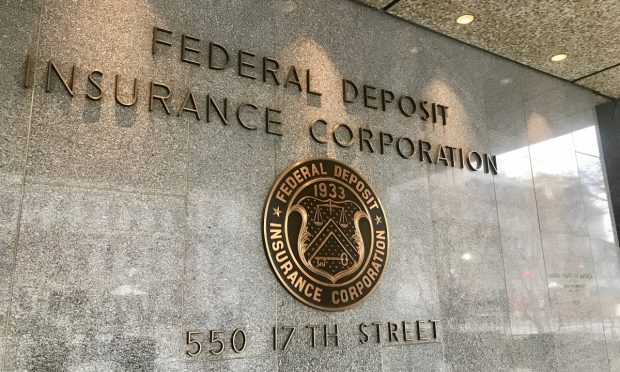FDIC’s Warning to Voyager Spotlights Broader Concerns about Insuring Crypto

The Federal Deposit Insurance Corporation (FDIC) just issued bankrupt crypto lender Voyager Digital a stern warning to stop “making false or misleading representations” implying that its customers’ funds are FDIC insured.
The warning isn’t really a marker its biggest concern about crypto’s impact on and potential use of FDIC insurance.
Aside from the Biden administration’s proposal that all stablecoin issuers be FDIC-insured banks — which is meeting a fair bit of opposition in Congress — the agency itself is worried about actually insured banks holding crypto for customers.
The more immediate concern of the (Thursday) July 28 joint statement by the FDIC and Federal Reserve Board was that, it alleged, the firm had “stated or suggested on its website, mobile app and social media accounts that Voyager itself is FDIC-insured; customers who invested with the Voyager cryptocurrency platform would receive FDIC insurance coverage … [and that] the FDIC would insure customers against the failure of Voyager itself.”
See also: FDIC Probes Voyager Digital Over Account Insurance Claims
In reality, the agencies said, Voyager kept customer funds at the FDIC-insured Metropolitan Commercial Bank, so those funds were insured only against the failure of that institution — not Voyager.
The agencies gave Voyager two days to remove anything that suggested otherwise and threatened unspecified further action.
It’s not the first time the issue has come up.
In May, the Consumer Financial Protection Bureau (CFPB) warned firms not to “misuse the name or logo of the FDIC or make deceptive representations about deposit insurance,” saying that “the issue has taken on renewed importance with the emergence of financial technologies — such as crypto-assets, including stablecoins — and the risks posed to consumers if they are lured to these or other financial products or services through misrepresentations or false advertising.”
Read more: CFPB Warns Businesses Not to Misrepresent FDIC Insurance
A Deeper Problem
On Feb. 7, Martin Gruenberg, acting chairman of the FDIC, called evaluating crypto-asset risks one of the agency’s five top priorities for 2022.
His concern was not about bankrupt crypto lenders like Voyager Digital, Celsius and Zipmex — they hadn’t shown any signs of collapse at that time.
What Gruenberg was worried about was insured federal banks getting into trouble if they “engage in crypto-asset-related activities,” potentially causing a contagion to spread into the broader financial system, potentially posing “significant safety and soundness and financial system risks.”
Also read: How a Stablecoin’s $48B Collapse Rippled Across Crypto
He added that federal banking regulators must “provide robust guidance” to the banking industries on these risks, both to their own institutions and their customers.
Put another way, Gruenberg didn’t want to find himself bailing out otherwise healthy banks that dipped their toes too deeply into the volatile and — the Securities and Exchange Commission has long argued — easily manipulated crypto market.
Nor was Gruenberg out in front of other officials in this regard. In November, Acting Comptroller of the Currency Michael Hsu reversed his pro-crypto predecessor’s ruling that banks could hold and use crypto assets, including stablecoin reserves, for customers as well as making payments and settling transactions.
You may like: Comptroller of the Currency Backpedals on Rulings Allowing Banks to Handle Crypto
While Hsu technically upheld those rulings, he added that institutions wanting to do so would require pre-approval from the Office of the Comptroller of the Currency (OCC) — which, he suggested quite strongly at the time and since, would not be forthcoming.
Related: US Comptroller Takes a Victory Lap on Crypto
In April, the FDIC ordered the institutions it supervises to notify the agency and await relevant supervisory feedback before engaging in any activity involving or related to crypto assets. At the time, the FDIC said they “may pose significant safety and soundness risks as well as financial stability concerns,” and that each crypto-related activity should be considered on an individual basis.
Legislation Coming
The FDIC entered the stablecoin side of the crypto regulation movement in November, when the President’s Working Group (PWG) on Financial Markets issued a stablecoin report concluding that all stablecoin issuers should be federally insured banks — with backing from the FDIC.
That’s proven controversial in Congress, in which a number of senators and representatives from states that issue their own charters to banks and other financial institutions want those institutions to be able to issue stablecoins as well.
Sen. Cynthia Lummis, R-Wyo., who is co-authoring a bipartisan crypto regulation bill, called the proposed requirement “misguided and wrong.”
On July 18, Treasury Department Undersecretary for Domestic Finance Nellie Liang told congress that the PWG recommendation had some “flexibility,” adding that it “was not meant to limit to current banks.”
More like this: US Treasury’s Liang Offers Path for Nonbank Stablecoins
The point is to have stablecoin issuers regulated for safety and soundness, she said. But, she added, that didn’t mean that they have to have deposit insurance. The idea is to bring them “into the banking system,” and having issuers be subsidiaries or affiliates of bank holding companies would work.
That doesn’t mean they won’t become banks. Circle, issuer of the No. 2 stablecoin USD Coin, or USDC, recently reiterated plans to apply for a national bank charter, adding that the move would come soon.
Either way, regulations that may require stablecoin issuers to be banks has been pushed back to 2023.
For all PYMNTS Crypto coverage, subscribe to the daily Crypto Newsletter.
